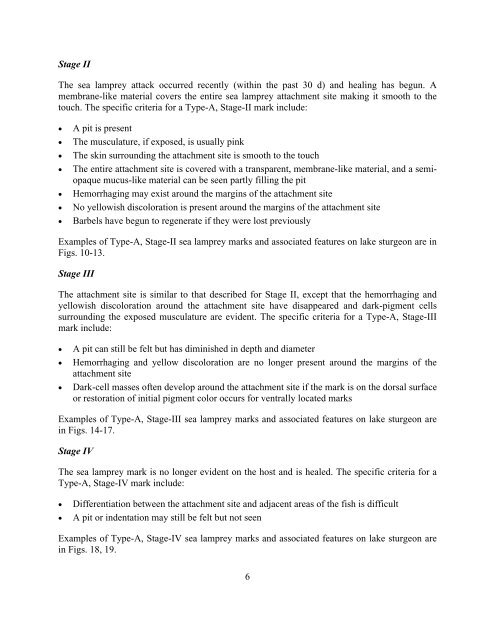application of a dichotomous key to the classification of sea lamprey ...
application of a dichotomous key to the classification of sea lamprey ...
application of a dichotomous key to the classification of sea lamprey ...
You also want an ePaper? Increase the reach of your titles
YUMPU automatically turns print PDFs into web optimized ePapers that Google loves.
Stage II<br />
The <strong>sea</strong> <strong>lamprey</strong> attack occurred recently (within <strong>the</strong> past 30 d) and healing has begun. A<br />
membrane-like material covers <strong>the</strong> entire <strong>sea</strong> <strong>lamprey</strong> attachment site making it smooth <strong>to</strong> <strong>the</strong><br />
<strong>to</strong>uch. The specific criteria for a Type-A, Stage-II mark include:<br />
• A pit is present<br />
• The musculature, if exposed, is usually pink<br />
• The skin surrounding <strong>the</strong> attachment site is smooth <strong>to</strong> <strong>the</strong> <strong>to</strong>uch<br />
• The entire attachment site is covered with a transparent, membrane-like material, and a semiopaque<br />
mucus-like material can be seen partly filling <strong>the</strong> pit<br />
• Hemorrhaging may exist around <strong>the</strong> margins <strong>of</strong> <strong>the</strong> attachment site<br />
• No yellowish discoloration is present around <strong>the</strong> margins <strong>of</strong> <strong>the</strong> attachment site<br />
• Barbels have begun <strong>to</strong> regenerate if <strong>the</strong>y were lost previously<br />
Examples <strong>of</strong> Type-A, Stage-II <strong>sea</strong> <strong>lamprey</strong> marks and associated features on lake sturgeon are in<br />
Figs. 10-13.<br />
Stage III<br />
The attachment site is similar <strong>to</strong> that described for Stage II, except that <strong>the</strong> hemorrhaging and<br />
yellowish discoloration around <strong>the</strong> attachment site have disappeared and dark-pigment cells<br />
surrounding <strong>the</strong> exposed musculature are evident. The specific criteria for a Type-A, Stage-III<br />
mark include:<br />
• A pit can still be felt but has diminished in depth and diameter<br />
• Hemorrhaging and yellow discoloration are no longer present around <strong>the</strong> margins <strong>of</strong> <strong>the</strong><br />
attachment site<br />
• Dark-cell masses <strong>of</strong>ten develop around <strong>the</strong> attachment site if <strong>the</strong> mark is on <strong>the</strong> dorsal surface<br />
or res<strong>to</strong>ration <strong>of</strong> initial pigment color occurs for ventrally located marks<br />
Examples <strong>of</strong> Type-A, Stage-III <strong>sea</strong> <strong>lamprey</strong> marks and associated features on lake sturgeon are<br />
in Figs. 14-17.<br />
Stage IV<br />
The <strong>sea</strong> <strong>lamprey</strong> mark is no longer evident on <strong>the</strong> host and is healed. The specific criteria for a<br />
Type-A, Stage-IV mark include:<br />
• Differentiation between <strong>the</strong> attachment site and adjacent areas <strong>of</strong> <strong>the</strong> fish is difficult<br />
• A pit or indentation may still be felt but not seen<br />
Examples <strong>of</strong> Type-A, Stage-IV <strong>sea</strong> <strong>lamprey</strong> marks and associated features on lake sturgeon are<br />
in Figs. 18, 19.<br />
6
















